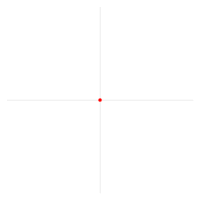Turn (angle)
[a] The angular unit of the turn is useful in connection with, among other things, electromagnetic coils (e.g., transformers), rotating objects, and the winding number of curves.The German standard DIN 1315 (March 1974) proposed the unit symbol "pla" (from Latin: plenus angulus 'full angle') for turns.While percentage protractors have existed since 1922,[18] the terms centiturns, milliturns and microturns were introduced much later by the British astronomer Fred Hoyle in 1962.In 1697, David Gregory used π/ρ (pi over rho) to denote the perimeter of a circle (i.e., the circumference) divided by its radius.The first use of the symbol π on its own with its present meaning (of perimeter divided by diameter) was in 1706 by the Welsh mathematician William Jones.Elsewhere in Introductio in analysin infinitorum, Euler instead used the letter π for one-fourth of the circumference of a unit circle, or 1.57... .[32][33] Several people have independently proposed using 𝜏 = 2π, including:[34] In 2001, Robert Palais proposed using the number of radians in a turn as the fundamental circle constant instead of π, which amounts to the number of radians in half a turn, in order to make mathematics simpler and more intuitive.[36] The same year, Thomas Colignatus proposed the uppercase Greek letter theta, Θ, to represent 2π.[39] In 2010, Michael Hartl proposed to use the Greek letter tau to represent the circle constant: τ = 2π.He also claims that the formula for circular area in terms of τ, A = 1/2𝜏r2, contains a natural factor of 1/2 arising from integration.[65] 𝜏 has been covered in videos by Vi Hart,[66][67][68] Numberphile,[69][70][71] SciShow,[72] Steve Mould,[73][74][75] Khan Academy,[76] and 3Blue1Brown,[77][78] and it has appeared in the comics xkcd,[79][80] Saturday Morning Breakfast Cereal,[81][82][83] and Sally Forth.[84] The Massachusetts Institute of Technology usually announces admissions on March 14 at 6:28 p.m., which is on Pi Day at Tau Time.[88][89] Rotation count or number of revolutions is a quantity of dimension one, resulting from a ratio of angular displacement.Common related units of frequency are hertz (Hz), cycles per second (cps), and revolutions per minute (rpm).[d] Despite their dimensional homogeneity, these two specially named dimensionless units are applicable for non-comparable kinds of quantity: rotation and angle, respectively.[e] The following table documents various programming languages that have implemented the circle constant for converting between turns and radians.



360 degrees (disambiguation)rotationsPlane angleradiansmilliradiansdegreesgradianscomplete anglesubtendedcircleangular unitcycles per secondrevolutions per minuteelectromagnetic coilstransformerswinding numberright anglemetric prefixesMichael Hartlcircumferenceradiusdimensionless quantitySI unitlegal unit of measurementHP 39gIIHP PrimenewRPLHP 50ghp 39g+HP 49g+HP 39gsHP 40gsWP 43Smultiples of πdegree21′ 36″protractorpercentageFred Hoylesatellite watchingBinary fractions of a turncompass pointsbinary radianDavid GregoryperimeterWilliam OughtredWilliam JonesLeonhard EulerMechanicaIntroductio in analysin infinitorumunit circleRobert P. CreaseJohn Horton ConwayEuler's identityintegrationKhan AcademyDesmos graphing calculatorPythonProcessingLiberty EiffeliPhoneList of formulae involving πArea of a circlesectorCauchy's integral formulaStandard normal distributionStirling's approximationnth roots of unityPlanck constantreduced Planck constantAngular frequencyVi HartNumberphileSciShowSteve Mould3Blue1BrownSaturday Morning Breakfast CerealSally ForthMassachusetts Institute of TechnologyPi DaySI unitUnitlessInternational System of Quantitiesphysical quantityrotational displacementISO 80000-3International System of Unitsquantity of dimension onerotational frequencyrate of changereciprocal secondRotationBase unitsdimensionless unitdimensional homogeneitykinds of quantityperiodCrystalEiffelAmpere-turnCycle per secondAngle of rotationRepeating circleSpat (angular unit)solid anglesteradiansUnit intervalModulo operationTwist (mathematics)CRC PressInstitution of Engineering and TechnologyTelegraph IndiaWall Street JournalFriedrich Vieweg & Sohn Verlagsgesellschaft mbHSpringer-VerlagSchweizerischer BundesratWP 34SconversionsHoyle, FredMacdonald & Co. (Publishers) Ltd.Dover Publications, Inc.Courier CorporationSimon & Schuster, Inc.Journal of the American Statistical AssociationAstronomische Mitteilungen der Urania-Sternwarte WienVolksbildungshaus Wiener Urania